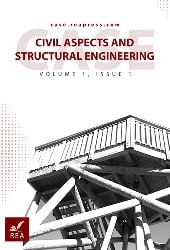Tensile and Compressive Strength Investigations of Ordinary Concrete and Pozzolanic Concrete and the Effect of Polypropylene on Them
Abstract
Fibers increase cohesion, increase tensile strength, reduce cracks, and increase the softness of concrete. The type of fibers used in concrete and their size depends on the type of concrete used and tensile strength. Fibers used in concrete can be glass, steel, or polymer fibers. Polypropylene fibers are economically efficient, and considering their favorable properties, in this research we examine the effect of these fibers on ordinary concrete and pozzolanic concrete. After preparing the necessary materials, which include cement, water, stone materials, and lubricants, it is necessary to prepare the additives required for concrete, which include polypropylene fibers and metakaolin pozzolan. The samples made in this research include control sample S and sample A1 with 0.2% by weight of polypropylene fibers and 5% by weight of metakaolin pozzolan, sample A2 with 0.2% by weight of polypropylene fibers and 10% by weight of metakaolin pozzolan, sample A3 with 2.2 0% by weight of polypropylene fibers and 10% by weight of metakaolin pozzolan, sample B1 has 0.5% by weight of polypropylene fibers and 5% by weight of metakaolin pozzolan, sample B2 has 0.5% by weight of polypropylene fibers and 5% by weight of metakaolin pozzolan, sample B3 has 0.5% by weight of polypropylene fibers and 15% by weight of metakaolin pozzolan, sample C1 has 1% by weight of polypropylene fibers and 5% by weight of metakaolin pozzolan, sample C2 has 10% by weight of polypropylene fibers and 10% by weight of metakaolin pozzolan, sample C3 has 1% by weight of polypropylene fibers and 15% by weight of metakaolin pozzolan. The use of polypropylene fibers reduces the compressive strength. It increases the tensile strength of the samples, and the use of high percentages of pozzolan improves the compressive strength and tensile strength.
Keywords:
Compressive strength, Tensile strength, Pozzolan, Polypropylene fibersReferences
- [1] Bagherzadeh, R., Pakravan, H. R., Sadeghi, A. H., Latifi, M., & Merati, A. A. (2012). An investigation on adding polypropylene fibers to reinforce lightweight cement composites (LWC). Journal of engineered fibers and fabrics, 7(4), 155892501200700400. https://doi.org/10.1177/155892501200700410
- [2] Barbhuiya, S., Kanavaris, F., Das, B. B., & Idrees, M. (2024). Decarbonising cement and concrete production: Strategies, challenges and pathways for sustainable development. Journal of building engineering, 86, 108861. https://doi.org/10.1016/j.jobe.2024.108861
- [3] Singh, A. K., Jain, A., & Jain, S. (2013). Rapid chloride permeability test of polypropylene and glass fiber reinforced concrete. International journal of engineering research & technology (ijert), 2(5), 534–543. https://doi.org/10.17577/IJERTV2IS50326
- [4] Yao, Y., Xu, G., Wu, M., & Zhao, M. (2023). Exploring the influence of cement and cement hydration products on strength and interfacial adhesion in emulsified cold recycled mixture: A molecular dynamics and experimental investigation. Construction and building materials, 409, 134050. https://doi.org/10.1016/j.conbuildmat.2023.134050
- [5] Wongtanakitcharoen, T., & Naaman, A. E. (2007). Unrestrained early age shrinkage of concrete with polypropylene, PVA, and carbon fibers. Materials and structures, 40, 289–300. https://doi.org/10.1617/s11527-006-9106-z
- [6] Tayeh, B. A., Hamada, H. M., Almeshal, I., & Bakar, B. H. A. (2022). Durability and mechanical properties of cement concrete comprising pozzolanic materials with alkali-activated binder: A comprehensive review. Case studies in construction materials, 17, e01429. https://doi.org/10.1016/j.cscm.2022.e01429
- [7] Ali, B., Yilmaz, E., Sohail Jameel, M., Haroon, W., & Alyousef, R. (2024). Consolidated effect of fiber-reinforcement and concrete strength class on mechanical performance, economy and footprint of concrete for pavement use. Journal of king saud university-engineering sciences, 36(3), 175–185. https://doi.org/10.1016/j.jksues.2021.09.005
- [8] Saeed, M. K., Rahman, M. K., & Baluch, M. H. (2019). Influence of steel and polypropylene fibers on cracking due to heat of hydration in mass concrete structures. Structural concrete, 20(2), 808–822. https://doi.org/10.1002/suco.201800144
- [9] Rodrı́guez-Camacho, R. E., & Uribe-Afif, R. (2002). Importance of using the natural pozzolans on concrete durability. Cement and concrete research, 32, 1851–1858. http://dx.doi.org/10.1016/S0008-8846(01)00714-1
- [10] Ahmed, A. (2019). Chemical reactions in pozzolanic concrete. Modern approaches on material science, 1. http://dx.doi.org/10.32474/MAMS.2019.01.000120
- [11] Mazzucco, G., & Xotta, G. (2016). Fire spalling prevention via polypropylene fibres: a meso-and macroscale approach. Modelling and simulation in engineering, 8639545. https://doi.org/10.1155/2016/8639545
- [12] Detwiler, R. J., Bhatty, J. I., & Battacharja, S. (1996). Supplementary cementing materials for use in blended cements. https://trid.trb.org/View/572805
- [13] Bertolini, L., Elsener, B., Pedeferri, P., Redaelli, E., & Polder, R. B. (2013). Corrosion of steel in concrete: prevention, diagnosis, repair. Wiley. https://books.google.com/books?id=7B9sug5DDHkC
- [14] Khan, K., Amin, M. N., Usman, M., Imran, M., Al Faiad, M. A., & Shalabi, F. I. (2022). Effect of Fineness and heat treatment on the pozzolanic activity of natural volcanic ash for its utilization as supplementary cementitious materials. Crystals, 12(2). https://doi.org/10.3390/cryst12020302


